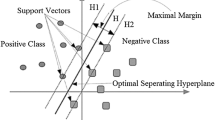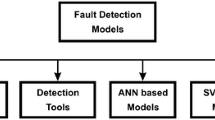Abstract
Health monitoring of bearings is very critical for satisfactory working of complex machinery. Thus, the ability to detect bearing faults and classify them based on their nature becomes very important aspect of health monitoring of machines. In the machine learning methodology for the fault taxonomy, the support vector machine (SVM) is well recognized for its generalization capabilities. In this work, the taxonomy of rolling element bearing faults has been discussed. Acceleration signatures are classified by the support vector machine (SVM) learning algorithm. The tuning of the SVM and kernel parameters is necessary for better taxonomy. The novelty of the paper is in comparing the ability to classify a set of faults by the tuned SVM and kernel parameters with the help of grid-search method (GSM), genetic algorithm (GA) and artificial bee colony algorithm (ABCA). Four fault settings along with no-fault condition were considered. Three statistical features were obtained from acceleration signatures. The fault taxonomy was performed at the identical rotational speed at which signals were captured. The taxonomy capability is observed and it depicted a very good prediction performance especially at higher speeds.
Access this chapter
Tax calculation will be finalised at checkout
Purchases are for personal use only
Similar content being viewed by others
References
Taylor JI (1995) Back to the basics of rotating machinery vibration analysis. Sound Vib 29(2):12–16
Randall RB, Antoni J (2011) Rolling element bearing diagnostics—a tutorial. Mech Syst Signal Process 25:485–520
Burgess CJC (1998) A tutorial on support vector machines for pattern recognition. Data Min Knowl Disc 2:955–974
Widodo A, Yang B-S (2007) Support vector machine in machine condition monitoring and fault diagnosis. Mech Syst Signal Process 21:2560–2574
Jack LB, Nandi AK (2002) Fault detection using support vector machines and artificial neural networks, augmented by genetic algorithms. Mech Syst Signal Process 16(2–3):373–390
Samanta B, Al-Balushi KR, Al-Araimi SA (2003) Artificial neural networks and support vector machines with genetic algorithm for bearing fault detection. Eng Appl Artif Intell 16:657–665
Huang C-L, Wang C-J (2006) A GA-based feature selection and parameters optimization for support vector machines. Expert Syst Appl 31:231–240
Rojas SA, Nandi AK (2006) Practical scheme for fast detection and classification of rolling-element bearing faults using support vector machines. Mech Syst Signal Process 20:1523–1536
Samadzadegan F, Soleymani A, Abbaspour Ali R (2010) Evaluation of genetic algorithms for tuning SVM parameters in multi-class problems. In: 11th IEEE international symposium on computational intelligence and informatics, Budapest, 18–20 Nov 2010
Kankar PK, Sharma SC, Harsha SP (2011) Fault diagnosis of ball bearings using machine learning methods. Expert Syst Appl 38:1876–1886
Bordoloi DJ Tiwari R (2013) Optimization of support vector machine based multi-fault classification with evolutionary algorithms from the time domain vibration data of gears. Proc Inst Mech Eng [C] J Mech Eng Sci 227(11):2428–2439 doi:10.1177/0954406213477777
Bordoloi DJ, Tiwari R (2013) Support vector machine based optimization of multi-fault classification of gears with evolutionary algorithms from time-frequency vibration data. Measurement 55:1–14
Vapnik VN (1995) The nature of statistical learning theory. Springer, New York
Cortes C, Vapnik V (1995) Support-vector network. Mach Learn 20(3):273–297
Boser BE, Guyon I, Vapnik V (1992) A training algorithm for optimal margin classifiers. In: Proceedings of the fifth annual workshop on computational learning theory, ACM Press, pp 144–152
Scholkopf B, Smola A, Williamson RC, Bartlett PL (2000) New support vector algorithms. Neural Comput 12:1207–1245
Knerr S, Personnaz L, Dreyfus G (1990) Single-layer learning revisited: a stepwise procedure for building and training a neural network. Neurocomputing: algorithms, architectures and applications, NATO ASI, Springer, Berlin, p 41–50
Kressel UHG (1998) Pairwise classification and support vector machines. In: Scholkopf B, Burges CJC, Smola AJ (eds) Advances in Kernel methods-support vector learning. MIT Press, Cambridge, pp 255–268
Hsu C-W, Lin C-J (2002) A comparison of methods for multi-class support vector machines. IEEE Trans Neural Netw 13(2):415–425
Chang C-C, Lin C-J (2011) LIBSVM: a library for support vector machines. ACM transactions on intelligent systems and technology, 2:27:1-27:27. http://www.csie.ntu.edu.tw/~cjlin/libsvm
Deb K (2003) Multi-objective optimization using evolutionary algorithms. Willey, Chichester
Deb K (1995) Optimization for engineering design: algorithms and examples. Prentice-Hall of India Pvt. Ltd, New Delhi
Houck CR, Joines J, Kay M (1996) A genetic algorithm for function optimization: a Matlab implementation. ACM transactions on mathematical software. http://www.ise.ncsu.edu/kay
Karaboga D, Basturk B, (2007) A powerful and efficient algorithm for numerical function optimization: artificial bee colony (ABC) algorithm. J Glob Optim, 39(3):459–171. http://www.mf.erciyes.edu.tr/abc
Karaboga D, Basturk B (2008) On the performance of artificial bee colony (ABC) algorithm. Appl Soft Comput 8(1):687–697
MATLAB (2009) Version 2, Package is used for the ABC algorithm. http://www.mf.erciyes.edu.tr/abc
Author information
Authors and Affiliations
Corresponding author
Editor information
Editors and Affiliations
Rights and permissions
Copyright information
© 2015 Springer International Publishing Switzerland
About this paper
Cite this paper
Bordoloi, D.J., Tiwari, R. (2015). Optimisation of SVM Methodology for Multiple Fault Taxonomy of Rolling Bearings from Acceleration Records. In: Pennacchi, P. (eds) Proceedings of the 9th IFToMM International Conference on Rotor Dynamics. Mechanisms and Machine Science, vol 21. Springer, Cham. https://doi.org/10.1007/978-3-319-06590-8_43
Download citation
DOI: https://doi.org/10.1007/978-3-319-06590-8_43
Published:
Publisher Name: Springer, Cham
Print ISBN: 978-3-319-06589-2
Online ISBN: 978-3-319-06590-8
eBook Packages: EngineeringEngineering (R0)




